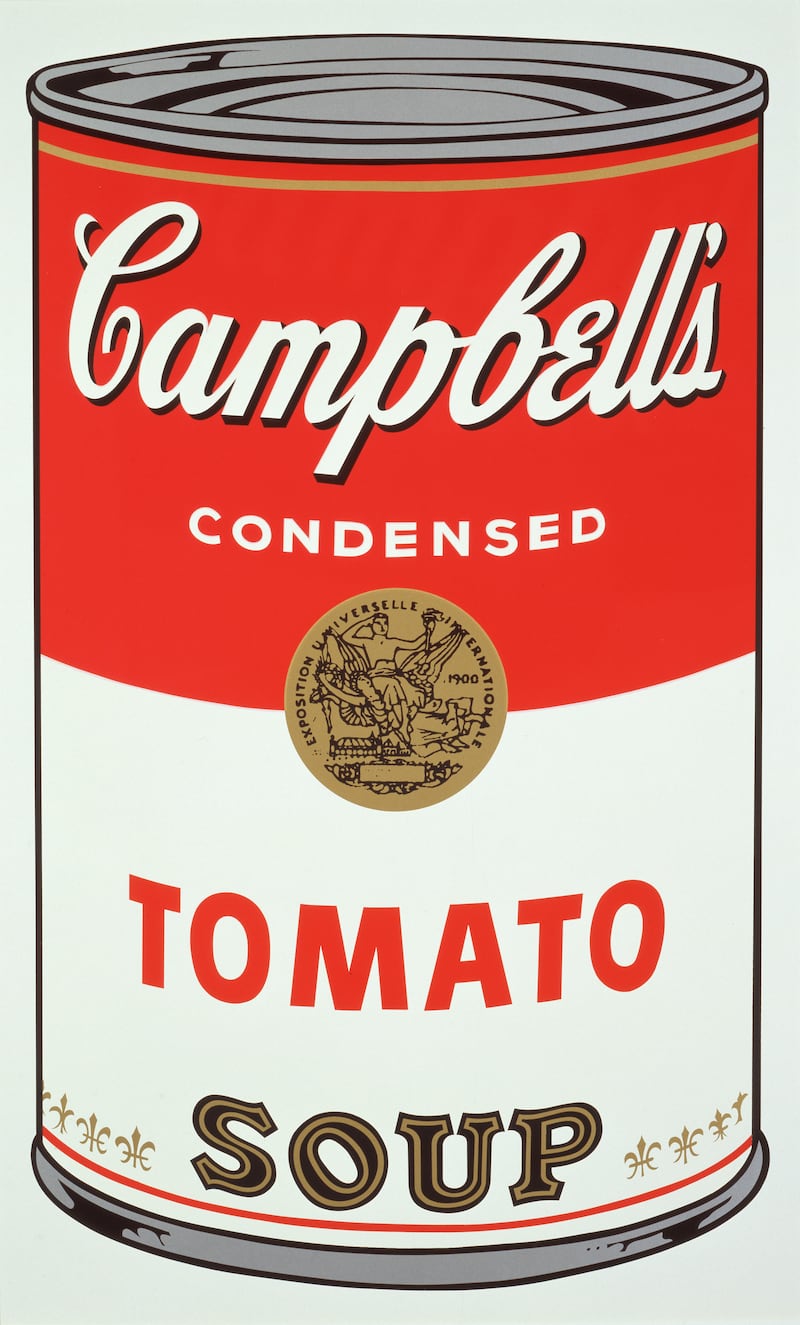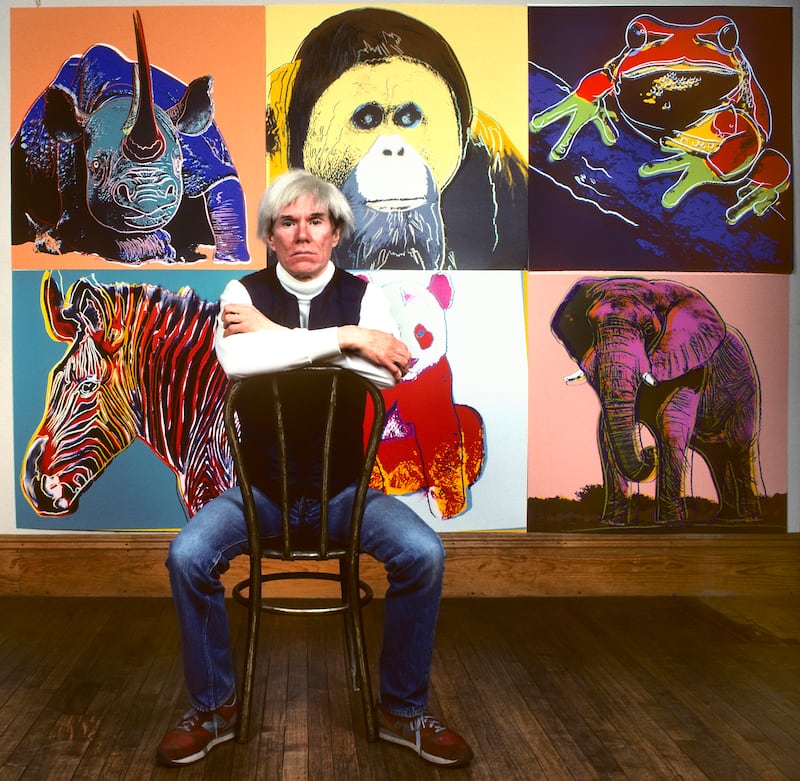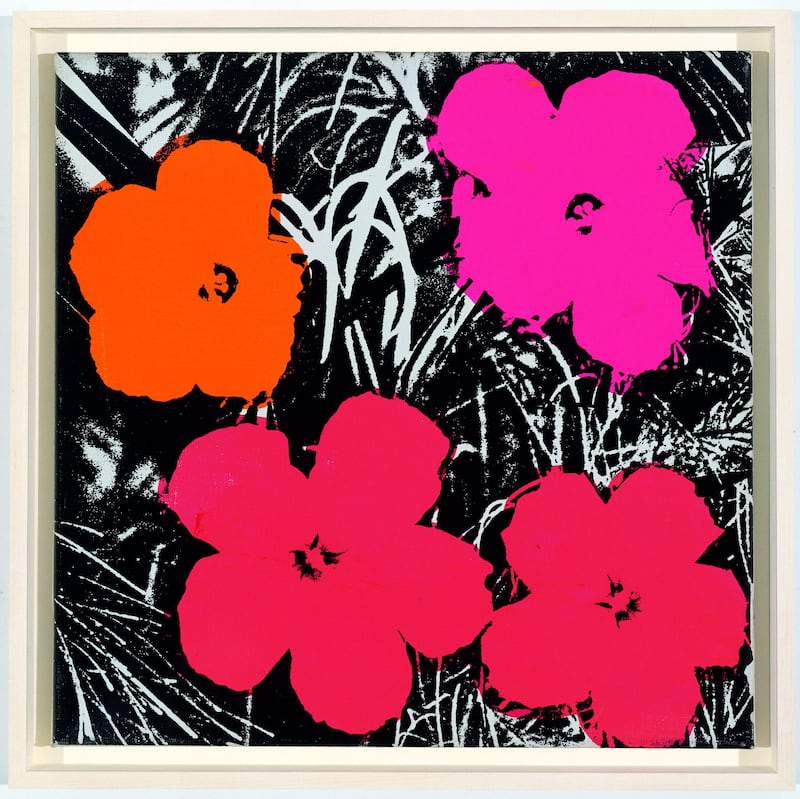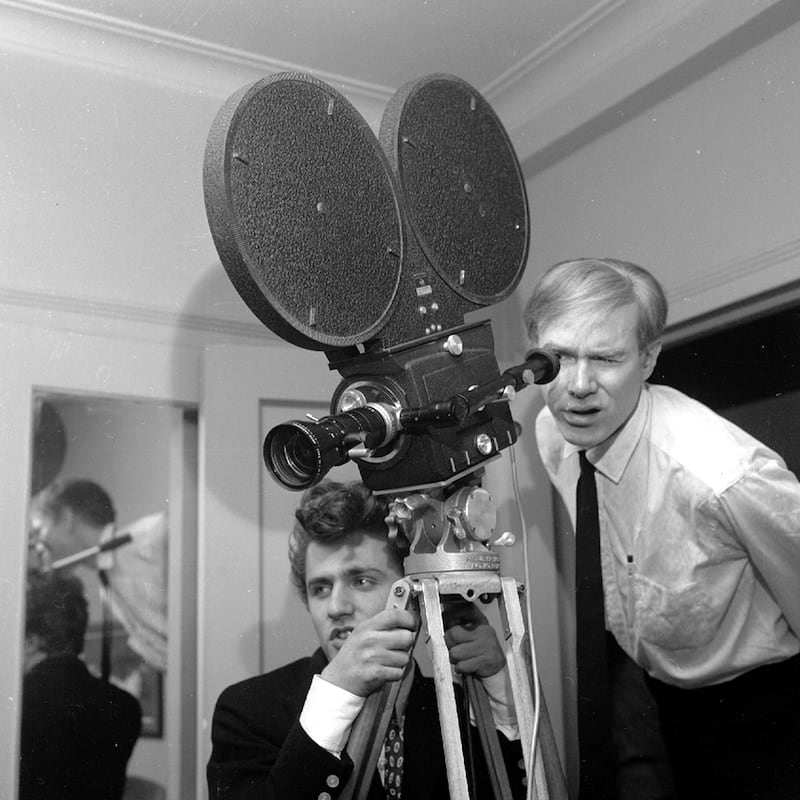An Andy Warhol exhibition is a big deal. Over the decades since his death in 1987, he has joined the select pantheon of artists whose posthumous fame extends to the general public, way beyond the bounds of those habitually attuned to the visual arts. And as with Leonardo da Vinci, Pablo Picasso or Vincent van Gogh, the very mention of his name triggers associations with particular images.
They might include, in Warhol’s case, a screen-printed Marilyn Monroe or Campbell’s soup cans. He even appropriated Leonardo’s Mona Lisa, just as he appropriated publicity and news image of Elizabeth Taylor, Mao Zedong and countless others. Brand managers can only dream about the level of success the Andy Warhol brand achieved and shows every sign of maintaining.
The Hugh Lane Gallery’s major Warhol exhibition, Three Times Out, has been five years in the planning. It features about 250 pieces and involved the co-operation of the Andy Warhol Museum in Pittsburgh and other institutions and private collections. Campbell’s soup cans, Marilyn Monroe and all Elizabeth Taylor feature, of course, together with Jackie Kennedy, Chairman Mao, skulls – a recurrent obsession – and the artist himself in some of his numerous self-portraits. Also included are an installation of inflated Silver Clouds and several of his pioneering film works, including Empire, Sleep and Kiss.
It’s not an overstatement to say that Warhol was instrumental in changing the nature of the contemporary art world, energising the market and setting an example for Damien Hirst, Jeff Koons and a host of other stars. How did he do it?
RM Block

In 1964, by then well-established as a rising star, he had his second exhibition at Eleanor Ward’s highly rated Stable Gallery in New York. He showed sets of box sculptures: multiple repeats of flat-coloured, screen-printed plywood boxes faithfully mimicking commercial products from Campbell’s, Del Monte, Heinz and Brillo. Warhol wanted them simply displayed, stacked as though in a supermarket. Now immediately recognisable as “Andy Warhols”, they drew a mixed response at the time, and they proved hard to sell. Without question, as a disciplined conceptual feat, perfectly thought through and beautifully delivered, the show was a remarkable achievement.
The philosopher Arthur Danto visited the exhibition. He had seen Warhol’s previous show there two years previously. But this one was, as he later wrote, “a transformative experience for me. It turned me into a philosopher of art.” He was particularly struck, for some reason, by the example of the Brillo soap-pad box. Even though many people claimed that it was not really art at all, he was sure it was art. But why was it art? Looking back more than 40 years later, he wrote that the box is Warhol’s most famous work, “and I consider it his masterpiece”.
Warhol’s genius, for him, was to take an everyday, mass-produced object familiar to millions of Americans and transform it into art and, more, into an abiding icon. It was, he suggests, nothing less than the end of art, in the sense of the end of a particular tradition and lineage of art. From then on anything, he argued, could be art if it was labelled as such by, as he termed it, the artworld. In other words, legitimacy was conferred by a level of consensus among a range of interested parties.
Warhol did not come up with his Brillo box sculpture on a whim or out of the blue. It emerged from a long process of work, thought, conversation and trial and error from about 1959 onwards. Born in Pittsburgh in 1928 to Slovak parents (with the surname Warhola), he showed early promise in art and went on to study at the Carnegie Institute of Technology, graduating as a specialist in pictorial design. With a friend, the painter Philip Pearlstein, he moved to New York in the summer of 1949. There he became a very busy, successful commercial artist, winning commissions as an advertising, magazine and book illustrator, and as a window dresser.

Although, it seems, he was always emotionally distanced personally, people were constantly drawn to him, and liked him. Perhaps his very remoteness – blankness isn’t too strong a word – was in itself fascinating. That generally worked in his favour, though later it led to disaster. In any case, he was certainly a very good listener and a clear thinker. He took ideas on board and he acknowledged where they came from. It’s fair to say that American pop art crystallised out of the mood of the times, against a background of the growth of consumer culture and mass media. A number of artists were working in that direction, among them Jasper Johns (Warhol bought one of his works), James Rosenquist, Robert Rauschenberg and Roy Lichtenstein.
Warhol had serious ambitions to become a fine artist and was actively looking for a way to make art with the kind of material that featured in his commercial work. He started making paintings based on comic-strip characters. In Leo Castelli’s gallery one day, the gallerist Ivan Karp showed him some new paintings by Lichtenstein. Warhol was staggered. Someone else had the same idea, and they were doing it superlatively well. Clearly he couldn’t keep going with comic-strip characters, but he was encouraged in the direction he was taking.
[ Andy Warhol works set for Gormley’s pop art showcaseOpens in new window ]
He consulted his friends, and one, Muriel Latow, suggested he paint everyday things, such as dollar bills or cans of soup. He invited another, the filmmaker Emile de Antonio, to look at two paintings he made of a bottle of Coke. One was deliberately “painterly”, with visible brush strokes and drips, whereas the other was impassively rendered, like an advertising graphic. Which did de Antonio prefer? De Antonio instantly and emphatically plumped for the neutral, graphic style. Warhol later said that de Antonio taught him everything he knew about painting.
At some point in the summer of 1962, Warhol heard about the technique of photo-silkscreen. He quickly realised that he had found his perfect medium: a means of reducing an existing image to its graphic essentials and producing multiple copies. It chimed perfectly with a sentiment he often expressed: “I like things to be exactly the same over and over again.” By allowing the random imperfections that tended to happen along the way, however, and by varying the background colour, for example, he could also introduce a degree of nuance and variety that would have the effect of making each work unique – important from the point of view of a gallerist selling otherwise identical objects.

His liking for repetition was certainly genuine – in 1962 he preferred that 32 individual Campbell’s Soup silkscreens be kept together as a unit, and often individual pieces he made tended to incorporate multiple repeat images. Later in his life, in his book POPism, he wrote, revealingly: “The more you look at the same exact thing, the more the meaning goes away, and the better and emptier you feel.” He said in his own life he felt removed, as if he was watching television, whereas if he watched television he would be drawn into whatever drama there was. He preferred nonfeeling.
[ Andy Warhol: Profound artist, affectless hero, subversive iconOpens in new window ]
That sounds slightly chilling. Although many Warhol exhibitions have emphasised the apparently cheerful, upbeat nature of a great deal of his work – the Flower silkscreens (the curator Henry Geldzahler had advised him to make more “positive” images at the time), the Silver Clouds (originally devised as a ballet backdrop), the Cow Wallpaper, the glittering celebrity imagery such as Elvis Presley – the prevailing mood is actually fairly bleak. Late in 1963, when he had established his first “Factory”, as habitues began to refer to his studio, he began to work on a series he called Death in America.
He drew on news photographs of police in Alabama setting dogs on civil-rights demonstrators, grisly car crashes before the widespread use of seatbelts, the electric chair at Sing Sing prison in New York (some of these images are on view in the Hugh Lane), the FBI’s most-wanted posters and Marilyn Monroe, who’d died after overdosing. The grieving Jackie Kennedy became a subject too after her husband’s assassination. Always, the grids of repeated images in heavy, overinked black were oppressive rather than cheering.

The Factory, especially in its second incarnation, at East 47th Street in Manhattan, its interior painted silver, became a magnet for all sorts of people, energies and multimedia events under the umbrella title Exploding Plastic Inevitable, which drew in The Velvet Underground and myriad other creatives and performers. Warhol, who had something of the voyeur about him, was the deadpanning master of ceremonies as an endless procession of people progressed through the Factory, many extremely capable and working industriously while there. He increasingly oversaw the production of his own work, which had grown to encompass film, rather than being directly involved. This was innovative at the time and it also recalled the way a busy studio-workshop in the Italian renaissance functioned.
[ The Velvet Underground: ‘Every part of their story is extremely powerful’Opens in new window ]
Warhol occupied an odd position. He was increasingly famous, in the United States and internationally, and he was both the generative centre of his own little world of “superstars” and wannabes and a man who was also enigmatic and intentionally passive and removed, a blank space on to which people projected their own hopes, desires and fantasies. That carried risks. He could easily have died when, in an extremely paranoid state, Valerie Solanas shot him at the Factory in June 1968.e to figure out which is the film and which the still, but of course there are always little flickers and marks on a moving image.
For Danto, Empire poses the question What is a film? The expected answer is that it has to do with movement and change but, he argues, Warhol demonstrates that the point is that it’s the film itself that moves, not the subject, and makes it a “movie”. He mentions that he once attended a showing at the Whitney Museum of American Art where, after a while, a viewer asked the gallery attendant when the screening was starting, only to be told that it had begun 15 minutes previously.

Warhol occupied an odd position. He was increasingly famous, in the United States and internationally, and he was both the generative centre of his own little world of “superstars” and wannabes and a man who was also enigmatic and intentionally passive and removed, a blank space on to which people projected their own hopes, desires and fantasies. That carried risks. He could easily have died when, in an extremely paranoid state, Valerie Solanas shot him at The Factory in June 1968.
Her aim was to gain notoriety and publicity by killing him. He had mislaid a script she’d given him to look at. Reportedly, he’d thought it was so pornographic that he suspected some kind of sting operation. She was bizarrely convinced that he was conspiring to take control of her writings. The curator who was with him was also shot but suffered only minor injuries. The one bullet that hit Warhol caused horrific damage to several organs, and physically and psychologically he was never the same afterwards. Already relatively withdrawn, and famously uneasy about any kind of physical contact, he became understandably nervous about who came close to him.
It’s true that, after his brush with death, in many respects he went on to flourish, becoming more and more famous and wealthy. In time there were trumpeted collaborations with Jean-Michel Basquiat and others. While Warhol had always been clear that art was, for him, a business, he had always managed to combine business with aesthetic ambition. Increasingly, however, he oriented himself towards a world of glitz and celebrity that seemed to trivialise the qualities of his earlier work. Long after his death, his apparently outlandish prediction that, “in the future, everyone will be famous for 15 minutes” seemed increasingly prescient as the era of reality television, celebrity obsession and social-media influencers exploded. If he was pointing to the shallowness of emergent consumer culture, he was on the button.

In the 1970s and 1980s, he did take some ideologically suspect turns, embracing the Ronald Reagan administration, for example, and the shah’s regime in prerevolutionary Iran. In his scathing critique of Warhol’s latter career, the critic Robert Hughes mentions an anecdote about an art-world observer chiding a member of Warhol’s entourage when they stopped off in London en route to a lavish bash in Tehran. “How could you?” he asked. “By jet,” was the droll response.
In terms of the art market, Warhol’s star has risen unstoppably. A great deal of his work is instantly recognisable, easily understood and as weightless as an advertisement. It appeals to old money and new money. But critically, as well, his reputation has grown. Danto’s estimation of his importance is not regarded as at all outlandish. But even Danto, who died in 2013, was relatively reticent when it came to the later work. The consensus view, and indeed Danto’s, is that Warhol’s golden period lasted from the early 1960s until he was shot by Solanas. Thereafter, a principle of diminishing returns appeared to set in.
He died in February 1987, following what should have been a relatively minor gall-bladder operation. It has emerged relatively recently that the surgery was much riskier than it seemed, given several underlying factors. Much has been made of the fact that one of his last works was based on Leonardo da Vinci’s Last Supper, but, as was often the case, the impetus came from elsewhere: an Italian curator putting together a group show had invited various international artists to respond to the iconic work.
Andy Warhol Three Times Out, curated by Barbara Dawson and Michael Dempsey, is at the Hugh Lane Gallery, Parnell Square, Dublin 1, from Friday, October 6th, 2023, until Sunday, January 28th, 2024. Tickets cost €15 for adults, €6 for children, €36 for families of up to two adults and three children, and €10 for students, the unwaged and people aged 65 or over; book online




















